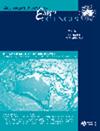维多利亚西部和中部早寒武世-早泥盆世沉积锆石年龄分布及暗示构造背景
IF 0.9
4区 地球科学
Q3 GEOSCIENCES, MULTIDISCIPLINARY
引用次数: 0
摘要
摘要维多利亚时代西部和中部古生代变质沉积岩碎屑锆石种群的年龄分布表明,大多数沉积在安第斯型弧后环境中,弧源和大陆沉积源的比例各不相同。值得注意的例外是上寒武纪诺斯利东部页岩和志留纪(?)的“Glen Creek Lithic Sandstone”样品,它们都含有单峰锆石种群。就诺斯利东页岩而言,该年龄与推断的沉积年龄非常接近,这意味着可能存在弧前环境,沉积物直接来自当代火山弧。另一方面,“Glen Creek Lithic Sandstone”的隐含沟槽环境很可能是从断层边界的、主要是寒武纪Glen Creck侵蚀窗中的非常局部的沉积物来源继承而来的。唯一被分析的可能在非弧形环境中沉积的岩石单元是志留纪中期的Humvale粉砂岩和下泥盆纪的Norton Gully砂岩。这些单元中的锆石种群带有强烈的大陆信号,它们可能沉积在以大陆块为界的伸展海洋盆地中。上志留系Grampians群可能沉积在类似的裂谷环境中,但该单元的锆石年龄直方图表明,它更接近弧形地体。沉积/构造环境的这些分配应被视为只是指示性的,特别是因为该方法只提供了一些伸展和会聚环境之间的细微区别。然而,如果任务是正确的,则对拉克伦造山带这一部分的地质历史有一些重要意义。例如,与目前的看法相反,Stawell带的岩石在奥陶纪期间可能没有显著隆起,本迪戈带的盆地可能一直在接受来自Grampians–Stavely带更西部的沉积物输入。维多利亚州西部和中部的早寒武纪至早泥盆纪沉积主要发生在弧后海洋盆地,最初与安第斯型边缘有关。在当地,一些寒武纪沉积物是在海沟或弧前环境中形成的,碎屑直接来自当代火山弧。寒武纪至志留纪弧后沉积物沉积在距离任何活动或弧前地体不同的距离处,并且大陆沉积物的贡献各不相同,但始终是主要的。墨尔本带的早泥盆纪沉积物可能沉积在实际上是陆内海洋裂谷的地方。本文章由计算机程序翻译,如有差异,请以英文原文为准。
Zircon age distributions and implied tectonic settings of early Cambrian to Early Devonian sedimentation in western and central Victoria
Abstract Age distributions among the detrital zircon populations in western and central Victorian Paleozoic metasedimentary rocks suggest that most were deposited in Andean-type back-arc environments, with variable proportions of arc and continental sediment sources. Notable exceptions are the upper Cambrian Knowsley East Shale and the Silurian(?) sample of ‘Glen Creek Lithic Sandstone’, which both contain unimodal zircon populations. In the case of the Knowsley East Shale, this age is very close to the inferred depositional age, implying a possible forearc environment, with sediment derived directly from the contemporary volcanic arc. On the other hand, the implied trench environment for the ‘Glen Creek Lithic Sandstone’ is most likely inherited from its very local sediment source in the fault-bounded and mainly Cambrian Glen Creek erosional window. The only analysed rock units that may have been deposited in non-arc settings are the middle Silurian Humevale Siltstone and the Lower Devonian Norton Gully Sandstone. The zircon populations in these units carry strong continental signals, and they may have been deposited in an extensional marine basin bounded by continental blocks. The upper Silurian Grampians Group may have been deposited in a similar rift setting, but the zircon age histogram for this unit suggests that it was more proximal to an arc terrane. These assignments of depositional/tectonic environment should be regarded as indicative only, particularly since the method provides only subtle distinctions between some extensional and convergent settings. However, if the assignments are correct, there are some important implications for the geological history of this part of the Lachlan Orogen. For example, contrary to present perceptions, the Stawell Zone rocks may not have been prominently uplifted during the Ordovician, and the basin in the Bendigo Zone may have been receiving sediment input from further west in the Grampians–Stavely Zone. Key points Early Cambrian to Early Devonian sedimentation in western and central Victoria occurred mainly in back-arc marine basins, initially associated with an Andean-type margin. Locally, some Cambrian sediments were formed in trench or forearc environments, with detritus supplied directly from a contemporary volcanic arc. Cambrian to Silurian back-arc sediments were deposited at varying distances from any active or former arc terranes and with varying but always major contributions of continent-derived sediments. Early Devonian sediments in the Melbourne Zone may have been deposited in what was effectively an intracontinental marine rift.
求助全文
通过发布文献求助,成功后即可免费获取论文全文。
去求助
来源期刊

Australian Journal of Earth Sciences
地学-地球科学综合
CiteScore
2.80
自引率
8.30%
发文量
45
审稿时长
6-12 weeks
期刊介绍:
Australian Journal of Earth Sciences publishes peer-reviewed research papers as well as significant review articles of general interest to geoscientists. The Journal covers the whole field of earth science including basin studies, regional geophysical studies and metallogeny. There is usually a thematic issue each year featuring a selection of papers on a particular area of earth science. Shorter papers are encouraged and are given priority in publication. Critical discussion of recently published papers is also encouraged.
 求助内容:
求助内容: 应助结果提醒方式:
应助结果提醒方式:


